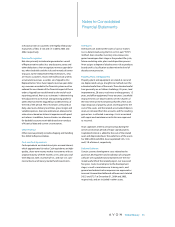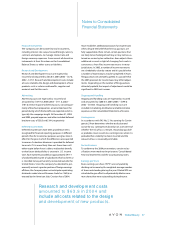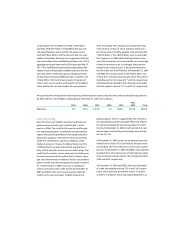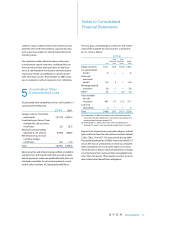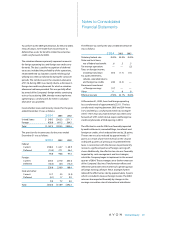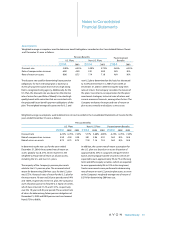Avon 2004 Annual Report Download - page 44
Download and view the complete annual report
Please find page 44 of the 2004 Avon annual report below. You can navigate through the pages in the report by either clicking on the pages listed below, or by using the keyword search tool below to find specific information within the annual report.
Global Beauty 65
Notes to Consolidated
Financial Statements
(income), net on the Consolidated Statements of
Income. Avon includes the change in the time value of
options in its assessment of hedge effectiveness. When
Avon determines that a derivative is not highly effective
as a hedge, hedge accounting is discontinued prospec-
tively. When it is probable that a forecasted transaction
will not occur, Avon discontinues hedge accounting for
the affected portion of the forecasted transaction, and
reclassifies gains and losses that were accumulated in
OCI to earnings in other expense (income), net on the
Consolidated Statements of Income.
Interest Rate Risk
Avon’s long-term, fixed-rate borrowings are subject to
interest rate risk. Avon uses interest rate swaps, which
effectively convert the fixed rate on the debt to a float-
ing interest rate, to manage its interest rate exposure.
At December 31, 2004 and 2003, Avon held interest
rate swap agreements that effectively converted approx-
imately 70% and 90%, respectively, of its outstanding
debt to variable interest rates based on LIBOR. Avon has
designated these fixed-to-variable interest rate swaps
as fair value hedges.
During 2004, Avon decided to reduce the proportion
of its debt that was based on variable interest rates
by entering into variable-to-fixed interest rate swap
agreements to offset a portion of its existing fixed-to-
variable interest rate swaps. In connection with that
decision, Avon simultaneously discontinued fair value
hedge accounting under FAS 133 for that portion of its
existing fixed-to-variable interest rate swaps. As a con-
sequence, under FAS 133, all future changes in the fair
market value of those existing fixed-to-variable swaps
and the new, offsetting variable-to-fixed swaps will be
reflected in interest expense. Avon expects that the
changes in fair value of these fixed-to-variable and
variable-to-fixed swaps will substantially offset each
other. At the time Avon entered into the new variable-
to-fixed swaps, the unrealized gain on the correspond-
ing fixed-to-variable swaps was $11.5. This unrealized
gain was recorded in debt and is now being amortized
to interest expense over the remaining term of the
original related fixed-rate debt.
At December 31, 2004 and 2003, Avon had interest rate
swaps designated as fair value hedges of fixed-rate
debt pursuant to FAS No. 133 (see Note 4, Debt and
Other Financing) with fair values of $11.6 and $31.1,
respectively. Additionally, at December 31, 2004, Avon
had interest rate swaps that are not designated as fair
value hedges with fair values of $10.9. Long-term debt
at December 31, 2004 and 2003 includes net gains of
$6.9 and $23.0, respectively, on interest rate swaps
designated as fair value hedges. Long-term debt also
includes remaining unamortized gains of $10.3 and
$9.3 at December 31, 2004 and 2003, resulting from
terminated swap agreements and swap agreements
no longer designated as fair value hedges, which are
being amortized to interest expense over the remain-
ing terms of the underlying debt. There was no hedge
ineffectiveness for the years ended December 31, 2004,
2003 or 2002, related to these interest rate swaps.
Foreign Currency Risk
Avon uses foreign currency forward contracts and
options to hedge portions of its forecasted foreign cur-
rency cash flows resulting from intercompany royalties,
intercompany loans, and other third-party and intercom-
pany foreign currency transactions where there is a high
probability that anticipated exposures will materialize.
These contracts have been designated as cash flow
hedges. The primary currencies for which Avon has net
underlying foreign currency exchange rate exposures
are the Argentine peso, Brazilian real, British pound,
Chinese renminbi, the Euro, Japanese yen, Mexican
peso, Philippine peso, Polish zloty, Russian ruble and
Venezuelan bolivar.
For the years ended December 31, 2004, 2003 and
2002, the ineffective portion of Avon’s cash flow foreign
currency derivative instruments and the net gains or
losses reclassified from OCI to earnings for cash flow
hedges that had been discontinued because the fore-
casted transactions were not probable of occurring
were not material.


